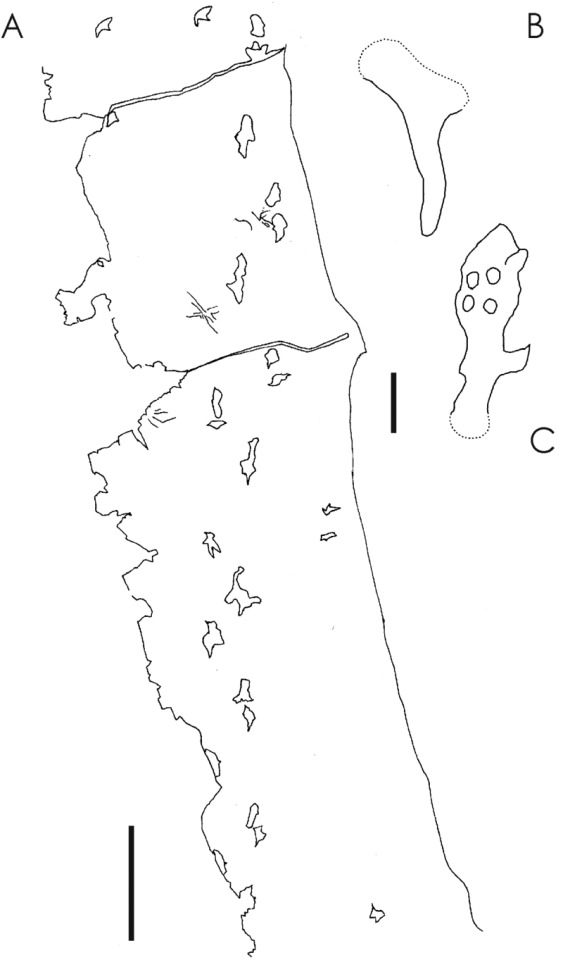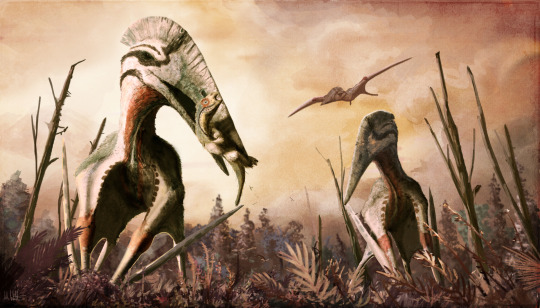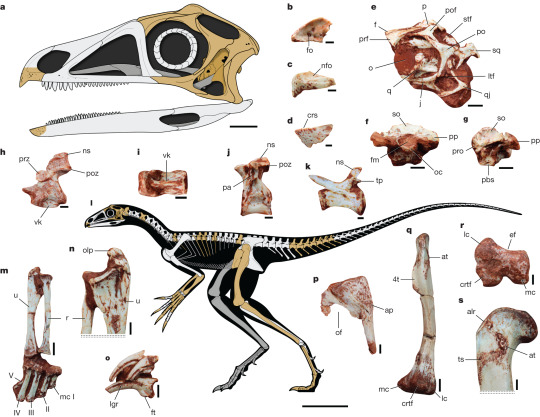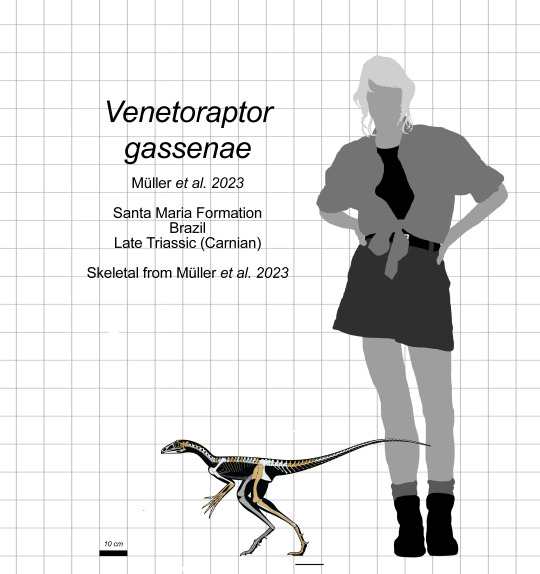#Ornithodiran
Explore tagged Tumblr posts
Note
Wait, pterosaurs aren't bipedal?
(I think i'm about to learn something)
Nope! Based on biomechanical modeling *and* footprint fossils, we know they were quadrupedal! They were also plantigrade, unlike dinosaurs (incl birds)! Yet another way dinosaurs are waaaaaay more birdie than pterosaurs.

Azhdarchid Trace Fossil

Azhdarchids, by Mark Witton, CC BY-SA 4.0
85 notes
·
View notes
Text

Still no new croc stuff from me (but I got something in the works), so instead more general paleonews. Today, a new pterosaur ancestor and it looks WEIRD.
This is Venetoraptor gassenae (Gassen's Plunderer from Vale Veneto) is a new lagerpetid literally just published a couple of minutes ago. According to its description (and as seen in the image) it had a toothless premaxilla that was hooked like the beak of a raptorial bird. It may have been covered in keratin, which is interesting as the skulls of early pterosaurs appear to have been smooth. The hands are obviously enormous and the size differences between the fingers are well in line with what pterosaurs would later have (i.e. the fourth finger is the longest, the fifth is reduced in Venetoraptor and absent in pterosaurs), but the legs are still much longer. The claws are described as sharp and scythe-like and again, its interesting that the fourth is the longest, as in other lagerpetids its usually the third that exceeds all others in length. Interesting connection between Veneto and pterosaurs for sure.

In terms of relationships it was found to be nested deep in lagerpetids, which, expectedly are recovered as the sister group to pterosaurs.
It seems to represent a whole new ecomorph not previously known from this group and interestingly coexisted not just with the related Ixalerpeton, but also with some early dinosaurs like Buriolestes. The beak is also interesting. Similar beaks have evolved multiple times in Triassic archosaurs and the hooked tip in particular is common even in modern birds, tho the authors argue that we know too little to say what precisely it was used for. Could be used for ripping flesh (like in falcons) or for eating fruit (like in parrots, fun fact, falcons and parrots are close relatives). As for the hand, the authors suggest that a big driver for ornithodirans playing around with them as the fact that they were not forced to be quadrupedal, so they could be more experimental, leading to hands fit for grasping, climbing and eventually flight.

Also for all those aware of the issues surrounding Brazilian fossils, rest assured, the fossil is being kept at the Centro de Apoio à Pesquisa Paleontológica da Quarta Colônia da Universidade Federal de Santa Maria, so it is in Brazil. The authors are primarily Brazilian (including the lead author Rodrigo Müller) and Argentinian, with two from the USA. Linke: New reptile shows dinosaurs and pterosaurs evolved among diverse precursors | Nature
#pterosauria#pterosaur#evolution#triassic#palaeoblr#paleontology#prehistory#venetoraptor#size comparisson#lagerpetidae
783 notes
·
View notes
Text
Bird Ape (Monster)

(Jape by @evolution-incarnate)
(This was scheduled for yesterday, which was my birthday, but uhhh i ran out of tumblr posts. So here it is now.
The bird ape here is a monster created top-down to be a monstersona of mine; the specimen above is Jape, a sunset bird ape or "junggalo", but there are less... clowny species, like the brown-with-purple-skin russet bird ape. They have their own phylogentic history, too; they're basal Ornithodiran archosaurs in an alternate history where the Permian extinction never happened. If that all was jibberish to you, don't worry about it lol)
(CR3 TN Medium Animal)
Bird apes, or "primaves" to scholars, are large, furry reptiles that live in tropical and subtropical forests, where they live in matriarchal family groups of up to a dozen (although usually less) and hunt for arboreal game. Of the bird ape species, only one- the sunset bird ape, the largest- regularly attacks humanoids; most prefer smaller prey and rarely, if ever, descend into the forest floor.
Bird apes are relatively intelligent animals, and their dexterity, ferocious appearance, and exoticism mean many outsiders seek to capture and train them as entertainment. Some bird apes take better to this than others, but all are wild animals, and a primave that has found itself in a traveling menagerie is always one missing key and a hungry night away from breaking out, whereupon it will frequently hunt livestock like goats or chickens. Particularly large- and particularly mistreated- animals appear to have the capacity to hold grudges and seek revenge, however, and a truly pissed off sunset bird ape falcon could kill a dozen people before being put down.
People who live alongside bird apes, however, tend to treat these animals with little concern, particularly the smaller species. Their meat is tough and gamey, and only the sunset bird ape is a threat to people. These animals are best left in peace.
Bird Ape Companion
Starting Statistics: AC: +3 Size: Small Speed: 20ft, Climb 30ft Attack: Bite (1d4), 2 Claw (1d4 plus Grab) Ability Scores: Str:11 Dex:18 Con:11 Int:2 Wis:16 Cha:8 Special Qualities: Arboreal Ambush, Impale (See below)
4th Level Advancement: AC: +2, Size: Medium Speed: +5ft, Climb +10ft Attack: Bite (1d6), 2 Claw (1d6) Ability Scores: Str +4, Dex -2, Con +2
This shaggy animal has long, muscular forearms that end in sharp claws, a long powerful tail, and a crocodilian grin.
Misc- CR3 TN Medium Animal HD4 Init:+7 Senses: Perception: +7 Stats- Str:15(+2) Dex:16(+3) Con:13(+1) Int:2(-4) Wis:16(+3) Cha:8(-1) BAB:+3 Space:5ft Reach:5ft Defense- HP:22(4d8+4) AC:18(+3 Dex, +5 Natural) Fort:+5 Ref:+7 Will:+4 CMD:18 Special Defenses: DR2/Bludgeoning Offense- Bite +1(1d6+1) 2 Claw +6(1d6+2 plus Grab) CMB:+5 (+2 Racial bonus to Grapple) Speed:25ft, Climb 40ft Special Attacks: Arboreal Ambush, Impale (1d6+2) Feats- Improved Initiative, Weapon Focus (Claw) Skills- Acrobatics +10, Climb +14, Stealth +7, Perception +7 (+4 Racial bonus to Acrobatics, +8 Racial bonus to Climb) Ecology- Environment- Forest (Temperate) Languages- None Organization- Solitary, Troop (3-6, 0-3 Young Bird Apes) Treasure- None Special Abilities- Arboreal Ambush (Ex)- When a bird ape makes a successful charge attack by jumping from a higher position, it deals an additional amount of damage equal to the appropriate fall damage for the height it fell. If it succeeds, the bird ape takes fall damage as though its fall had been 15 feet shorter. If the attack fails, the bird ape takes fall damage as normal. It may make an acrobatics check to further reduce its own fall damage as normal. At the end of this attack, it lands on a square adjacent to its target. Impale (Ex)- The long, piercing claws of a bird ape sink into its target when grappling. Upon making a successful grapple attempt with its claws, a bird ape deals 1d6+2 damage, as with the Constrict universal monster rule. The damage bonus is strength-based.
51 notes
·
View notes
Text

Reconstruction of the early dinosaur Herrerasaurus ischigualastensis from the Late Triassic (Carnian stage) Argentina. This genus was described by Osvaldo Reig back in 1963, but due to the fragmentary nature of the bones, the classification of the animal was controversial (opinions were expressed that it was a prosauropod or even a dinosaur outside the two main groups). Only in 1988 was a complete skeleton with a skull found, which allowed reconstructing the dinosaur and its approximate kinship. However, it is still unclear whether Herrerasaurus was an early theropod or whether it was closer to sauropodomorphs. The remains, named Ischisaurus cattoi and Frenguellisaurus ischigualastensis, were later assigned to Herrerasaurus.
Herrerasaurus is interesting for its rather large size for an early predatory dinosaur: some specimens of "Frenguellisaurus" reached 6 m. The skull was relatively small, but the jaws carried sharp saw-toothed teeth, including "fangs". There was also a shock-absorbing joint in the middle of the jaw, which allowed holding large prey. The hands were armed with three grasping fingers, and the longest of them was the third. The rudimentary fourth and fifth fingers were hidden by soft tissues. The pelvis of a Herrerasaurus is unusual. Only two sacral vertebrae fused with it (at least 3 in other dinosaurs), and the acetabulum was not completely open. At the same time, the pubic bone was directed not forward, but backward, as in maniraptorans, and carried a massive "boot". At one time, this served as the basis for Gregory Paul to designate the herrerasaurs as an early group in which bird-like features arose, and even to bring them closer to the "protoavis".
In this work, I tried out a style with shading using a black pencil, not a pen. It is much easier to apply shadows with a pencil, and I liked the result. It shows an extensive cover of filaments inspired by a possible "fluffy" ancestral state for ornithodirans (dinosaurs, pterosaurs and small groups close to them).
Black ballpoint pen and black colored pencils, 2023.
#herrerasaurus ischigualastensis#herrerasaurus#frenguellisaurus#ischisaurus#sanjuansaurus#staurikosaurus#herrerasauridae#saurischia#early dinosaurs#late triassic fauna#paleoart
28 notes
·
View notes
Note
Very sorry but pterosaurs did have feathers, not pennaceous ones like birds but iirc their pycnofibers are now considered to be true feathers. This also makes simple feathers (basically just fur but made of type b keratin) an ancestral trait of all ornithodirans
Yeah, I know. but they didn't have flight feathers nor feathered wings. That was the point I was trying to make.
5 notes
·
View notes
Text
My friends have convinced me that Titans are ornithodiran archosaurs (or, well, archosaur-adjacent because majik) and now I'm gonna make it everyone else's problem.
I will now proceed NOT to elaborate or maybe I will when reblogging someone idk
0 notes
Text
Don't worry Cait, Ava can and will pull up a chart on her phone for a visual aid--just give her a second.

"Nope! Crocodilians and all their relatives are more closely related to each other than to the Ornithodirans. There's a lot of differences, in fact--dinosaurs hold their limbs straight under their bodies and have a unique, hinged ankle joint, features that crocodilians don't have. There were some extinct groups that had the 'under the body' leg arrangement, but they were pretty derived examples..."
Ava bounced in place happily. "Ooh, really?! How big was it? Fully grown? Oh, fun fact: Sarcosuchus isn't actually a true crocodilian, it's a distant relative that just happens to look very similar to modern crocs!"
She nods along trying to remember all the scientific names, though likely she'll need to read them to properly later to really make them stick.
"Oh! So crocodiles aren't actually dinos? Shame, I was quite fond of the narrative of 'living dinos'...you know, aside from birds and cute paleontologist girls~"
"Did you know that when I was young my parents took me to an excavation site near the River Pilt where a Sarcosuchus imperator fossil was found?"
43 notes
·
View notes
Photo

Weird Triassic Reptile Drawing no. 3 - “U have done me a big frighten”
An unsuspecting Scleromochlus is startled by another member of his species landing on the ground in front of him. Comical faces ensue.
Scleromochlus is a strange little Triassic reptile that is currently thought to be fairly closely related to the ancestors of pterosaurs and dinosaurs. Since pterosaurs and dinosaur were both covered in fuzzy stuff, it is plausible that Scleromochlus had similar fuzz as well.
I say “fuzzy stuff” as a general term because the structures developed in different directions once pterosaurs split off the family tree. Dinosaurian fuzz became the first “proto-feathers”, which later evolved into more advanced forms, while pterosaur fuzz stayed fairly hair-like, and is called “pycnofibres”.
Scleromochlus had very long legs in proportion to the rest of its body. Unusually for a reptile, these legs seem fairly well-adapted to hopping, suggesting that Scleromochlus may have bounced around like an Australian desert hopping-mouse (look them up, they’re adorable). This would have undoubtedly enhanced their ability to do a big frighten to other Scleromochlus.
Oh, and Scleromochlus is not a dinosaur either. Just thought I’d make it clear.
#art#scleromochlus#triassic reptiles#not a dinosaur#ornithodiran#graphite#pencil#palaeoart#palaeontology#palaeoblr
333 notes
·
View notes
Note
Are birds reptiles or do they get their own classification? Been debating this with others for so long.
if you follow strict phylogeny, they’re both!
so the way it works is that any species of animal retains the classifications of its ancestors, no matter how long ago it was or how ridiculous it is to do that.
this is why we can correctly say that whales are ungulates- whales evolved from an early ungulate, so they get to keep the label even though they don’t actually have hooves anymore! or legs, even.
so by this logic, we can say that a bird IS a Theropod AND a Saurischian AND a Dinosaur AND a Dinosauriform AND a Dinosaurimorph AND an Ornithodiran AND an Avemetatarsilian AND an Archosaur AND above that, a Reptile! try keeping all that straight.

however, a bird is NOT a Psuedosuchian, because that is a different reptile lineage that also sprang off the Archosaur branch but has no direct line of descendence to birds themselves.
622 notes
·
View notes
Photo

kongonaphon, a tiny lagerpetid ornithodiran archosaur from the mid triassic of madagascar that was revealed only a few days ago. thought it would be fun to try out drawing something very recently described
481 notes
·
View notes
Text
There's mounting evidence that "pycnofibres" are actually feathers as well, meaning that all ornithodirans (the group containing both pterosaurs and dinosaurs) were probably descended from feathered ancestors

Sauron. DINOSAURS ALSO HAD FEATHERS X Men Unlimited Infinity 45
342 notes
·
View notes
Note
I’d say “anthrosaurs” bc the “saur” suffix encompasses both dinoSAUR and pteroSAUR without being dino-specific
Yeah fair, it just feels weird with Neornithine dinosaurs bc we don't usually use "saur" to refer to them
(and I mean Neornithes - Avisaurus is an Enant)
9 notes
·
View notes
Note
Have you seen Campione et al., 2020? It says that feathers are not basal for dinosaurs.
I have. Their study builds upon Barrett et al. (2015), which favored the same conclusion. However, that study has been criticized for the fact that half of their analyses assumed that pterosaurs were ancestrally scaly (and lacked filaments), an assumption that, though not impossible, is not supported by any direct evidence and is likely to inherently bias the analyses in favor of ancestrally unfeathered dinosaurs.
Campione et al. (2020) updated the study from Barrett et al. with some modifications:
They added crurotarsans as an additional outgroup, scored as scaly, of course. (No, contrary to what one may have heard in some circles, there is currently no good reason to think that any non-ornithodiran archosaurs had filamentous integument.)
They added analyses in which pterosaurs were scored as having “unique” integument distinct from either scales or filaments.
They added analyses in which ornithischians and theropods are placed as closer relatives to each other than to sauropodomorphs (the Ornithoscelida hypothesis).
They added analyses that assume an unequal-rates model of evolution (which allows changes between different types of integument to occur at different rates) and progressive models (which do not permit fuzzy taxa to revert back to a scaly state).
All in all, they ran 88 different analyses to account for all of their varying assumptions and variables (not including the analyses in which they added hypothetical Triassic feathered dinosaurs to see how that would impact the results). As you know, the majority of their analyses still favored a scaly ancestral dinosaur. Mark Witton (who had criticized the the original Barrett et al. study) is on record as having found the new study pretty convincing.
However... I still have some reservations. 32 of the analyses still operated under the assumption that pterosaurs were ancestrally scaly, the very thing that they had originally been criticized for. And this particular variable makes a big difference in the inference of ancestral states in this study, as shown in their figure below:

This figure shows the inferred likelihood of different integumentary states in the ancestral dinosaur under different assumptions. The analyses depicted in graphs A and B assume ancestrally scaly pterosaurs, those in C and D assume ancestrally fuzzy pterosaurs, and those in E and F assume that pterosaur integument was “unique”. All the graphs on the left assume the traditional Saurischia hypothesis of dinosaur interrelationships, whereas all of those on the right assume the Ornithoscelida hypothesis.
As you can see, assuming that pterosaurs were ancestrally scaly overwhelmingly favors ancestrally scaly dinosaurs. When they are assumed to have been ancestrally fuzzy, the chances of the ancestral dinosaur being scaly vs. fuzzy are much closer to each other, to the point where there is a large amount of overlap between the two options under the Ornithoscelida model.
Furthermore, the argument could be made that not all of the models tested in this study were equally likely. For example, many of the analyses considered scales, unbranched filaments, and branching feathers to be independent states of the same character, such that each of these states can switch between one another (sometimes all with equal likelihood). Yet we know that branching feathers most likely evolved from simpler filaments, so a transition from scales directly to branching feathers probably should not be considered equivalent to a transition from unbranched filaments to branching feathers.
If one discards the analyses that use these implausible assumptions, the ones left over suggest a more mixed signal. In fact, some of them do favor ancestrally fuzzy dinosaurs! That being said, on average, the support for an ancestrally scaly dinosaur is still higher under the experimental design used here. However, this does suggest that the data we currently have contains a more ambiguous signal than we might like. In other words, though an impressive number of models favor ancestrally scaly dinosaurs in this study, I don’t think that all of them should be taken with equal weight.
At SVP 2018, Thomas Holtz presented a poster in which he ran his own ancestral state reconstruction analyses. The results haven’t been published yet, but he has shared the poster on his website. A notable difference between his study and that of Campione et al. is that he didn’t score scales and filaments as alternatives of the same character. (After all, an animal can have both scales and filaments at the same time.) Instead, he scored taxa based on the presence vs. absence of filaments.
Like Campione et al., Holtz found that pterosaurs were critical to this problem. If pterosaur filaments are scored as being different from those of dinosaurs, support for an ancestrally unfeathered dinosaur is strong. However, if pterosaur and dinosaur filaments are scored the same, filaments are overwhelmingly inferred to have been ancestral to dinosaurs. In addition, if only taxa that have been found in Konservat-Lagerstätten (which are more likely to preserve a complete record of an animal’s integument) are scored, the ancestral state for dinosaurs becomes essentially ambiguous.
96 notes
·
View notes
Text
Teraterpeton hrynewichorum

By @stolpergeist
Etymology: Wonderful creeping thing
First Described By: Sues, 2003
Classification: Biota, Archaea, Proteoarchaeota, Asgardarchaeota, Eukaryota, Neokaryota, Scotokaryota, Opimoda, Podiata, Amorphea, Obazoa, Opisthokonta, Holozoa, Filozoa, Choanozoa, Animalia, Eumetazoa, Parahoxozoa, Bilateria, Nephrozoa, Deuterostomia, Chordata, Olfactores, Vertebrata, Craniata, Gnathostomata, Eugnathostomata, Osteichthyes, Sarcopterygii, Rhipidistia, Tetrapodomorpha, Eotetrapodiformes, Elpistostegalia, Stegocephalia, Tetrapoda, Reptiliomorpha, Amniota, Sauropsida, Eureptilia, Romeriida, Diapsida, Neodiapsida, Sauria, Archosauromorpha, Crocopoda, Allokotosauria, Trilophosauridae
Status: Extinct
Time and Place: 237 to 227 million years ago, in the Carnian of the Late Triassic

Teraterpeton is known from Nova Scotia.

Physical Description: Teraterpeton was a bizarre archosauromorph. It is an allokotosaur, a member of a clade of relatively large herbivorous archosauromorphs. Some of them, including Teraterpeton, have snouts that lack teeth at the front, but have teeth posteriorly. These toothless regions may have been covered by a “beak” of sorts, similar to those that would evolve many times in ornithodirans. Teraterpeton stands out from its relatives because its snout is very long; about half of the skull would have been the front beak! The front of the upper and lower jaws are toothless and would have tapered to a narrow point anteriorly. The teeth, which were present further back in the jaw, were shaped so that the upper teeth formed a perfect contact with the lower teeth.
Further back on the skull, both the orbit and the nasal openings were large. Also interestingly, one of the temporal fenestrae at the back of the skull is closed. Most diapsids have two large holes in the back of the skull, upper and lower temporal fenestrae. In Teraterpeton, the lower temporal fenestra is closed. This “euryapsid” condition is also present in the marine ichthyosaurs and sauropterygians. Teraterpeton’s neck vertebrae Teraterpeton would have had moderately long legs and a sprawing gait. The claws on both the hands and feet were relatively large.
Diet: Teraterpeton was herbivorous; it likely used the beak at the front to snip off plant matter and used the posterior teeth to chew them up.
Behavior: Unfortunately, little is known about the behavior of allokotosaurs. The limbs were not well-suited for deep digging, but the large claws indicate that they may have been used to grab at something in the ground, such as exposed roots. Like the related Trilophosaurus, Teraterpeton probably grew relatively slowly, and may have had a lower metabolism than more derived archosauromorphs.
Ecosystem: The Wolfville Formation of Nova Scotia is a sandstone, indicating that Teraterpeton lived in a desert. It’s difficult identifying most of the skeletons from this area, as preservation is generally not great, but other creatures that lived in the area include the cynodont Arctotraversodon and the temnospondyl “Metoposaurus” bakeri.
Other: Allokotosaurs are a truly bizarre group of archosauromorphs. There are two main clades: Azendohsauridae, which includes Azendohsaurus, Malerisaurus, and Shringasaurus, and Trilophosauridae, which includes Teraterpeton, Trilophosaurus, Spinosuchus, Variodens, and three scrappy things from Russia that were first identified as procolophonids. There’s also the long-necked, insectivorous Pamelaria, which is just kind of its own thing.
~ By Henry Thomas
Sources under the cut
Marsh, A.D., Parker, W.G., Kligman, B.T., Lessner, E.J. 2017. Bonebed of a carnivorous archosauromorph from the Chinle Formation (Late Triassic: Norian) of Petrified Forest National PArk. GSA Annual Meeting, Seattle.
Pritchard, A.C., Sues, H.-D. 2019. Postcranial remains of Teraterpeton hrynewichorum (Reptilia: Archosauromorpha) and the mosaic evolution of the saurian postcranial skeleton. Journal of Systematic Palaeontology.
Sues, H.-D. 2003. An unusual new archosauromorph reptile from the Upper Triassic Wolfville Formation of Nova Scotia. Canadian Journal of Earth Sciences 40: 635-649.
Werning, S., Irmis, R. Reconstruction the ontogeny of the Triassic basal archosauromorph Trilophosaurus using bone histology and limb bone morphometrics. 70th Annual Meeting of the Society of Vertebate Paleontology, Pittsburgh.
#teraterpeton#allokotosaur#archosauromorph#triassic#triassic madness#triassic march madness#prehistoric life#paleontology
178 notes
·
View notes
Photo

Some Ornithodirans with speculative integument! The Ixalerpeton is not “fluffy”, those long things are just weird scales. I did this for an art contest on a Discord server I’m on. I only recently switched this blog from a FF7 fandom blog to a general art blog (where I will post my paleoart and other animal art), so more stuff like this is coming! I’m looking to connect with other paleoartists on this site, too. My DeviantART - Anguilupus (to be changed to Knarme in the future)
My IG/Twitter - Knarme
#palaeoart#paleoart#triassic#triassicperiod#archosaur#archosauria#ornithodira#dinosauria#dinosaur#dinosaurart#eoraptor#lagerpetidae#lagerpetid#aphanosaur#aphanosauria#palaeobiology
19 notes
·
View notes
Note
What do you think of the theory that fur first evolved for sensory purposes in therapsids (similar to arthropod setae) before becoming integument?
This has also been suggested for ornithodiran feathers, for the record. I think it’s plausible.
6 notes
·
View notes